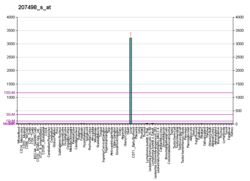Cytochrome P450 2D6 (CYP2D6) is an enzyme that in humans is encoded by the CYP2D6 gene. CYP2D6 is primarily expressed in the liver. It is also highly expressed in areas of the central nervous system, including the substantia nigra.
CYP2D6, a member of the cytochrome P450 mixed-function oxidase system, is one of the most important enzymes involved in the metabolism of xenobiotics in the body. In particular, CYP2D6 is responsible for the metabolism and elimination of approximately 25% of clinically used drugs, via the addition or removal of certain functional groups – specifically, hydroxylation, demethylation, and dealkylation.[5] CYP2D6 also activates some prodrugs. This enzyme also metabolizes several endogenous substances, such as N,N-Dimethyltryptamine, hydroxytryptamines, neurosteroids, and both m-tyramine and p-tyramine which CYP2D6 metabolizes into dopamine in the brain and liver.[5][6][7]
Considerable variation exists in the efficiency and amount of CYP2D6 enzyme produced between individuals. Hence, for drugs that are metabolized by CYP2D6 (that is, are CYP2D6 substrates), certain individuals will eliminate these drugs quickly (ultrarapid metabolizers) while others slowly (poor metabolizers). If a drug is metabolized too quickly, it may decrease the drug's efficacy while if the drug is metabolized too slowly, toxicity may result.[8] So, the dose of the drug may have to be adjusted to take into account of the speed at which it is metabolized by CYP2D6.[9] Individuals who exhibit an ultrarapid metabolizer phenotype, metabolize prodrugs, such as codeine or tramadol, more rapidly, leading to higher than therapeutic levels.[10][11] A case study of the death of an infant breastfed by an ultrarapid metabolizer mother taking codeine impacted postnatal pain relief clinical practices, but was later debunked.[12] These drugs may also cause serious toxicity in ultrarapid metabolizer patients when used to treat other post-operative pain, such as after tonsillectomy.[13][14][15] Other drugs may function as inhibitors of CYP2D6 activity or inducers of CYP2D6 enzyme expression that will lead to decreased or increased CYP2D6 activity respectively. If such a drug is taken at the same time as a second drug that is a CYP2D6 substrate, the first drug may affect the elimination rate of the second through what is known as a drug-drug interaction.[8]
- ^ a b c ENSG00000275211, ENSG00000280905, ENSG00000282966, ENSG00000283284, ENSG00000272532 GRCh38: Ensembl release 89: ENSG00000100197, ENSG00000275211, ENSG00000280905, ENSG00000282966, ENSG00000283284, ENSG00000272532 – Ensembl, May 2017
- ^ a b c GRCm38: Ensembl release 89: ENSMUSG00000061740 – Ensembl, May 2017
- ^ "Human PubMed Reference:". National Center for Biotechnology Information, U.S. National Library of Medicine.
- ^ "Mouse PubMed Reference:". National Center for Biotechnology Information, U.S. National Library of Medicine.
- ^ a b Wang B, Yang LP, Zhang XZ, Huang SQ, Bartlam M, Zhou SF (2009). "New insights into the structural characteristics and functional relevance of the human cytochrome P450 2D6 enzyme". Drug Metabolism Reviews. 41 (4): 573–643. doi:10.1080/03602530903118729. PMID 19645588. S2CID 41857580.
- ^ Wang X, Li J, Dong G, Yue J (February 2014). "The endogenous substrates of brain CYP2D". European Journal of Pharmacology. 724: 211–218. doi:10.1016/j.ejphar.2013.12.025. PMID 24374199.
- ^ Good M, Joel Z, Benway T, Routledge C, Timmermann C, Erritzoe D, et al. (22 April 2023). "Pharmacokinetics of N,N-dimethyltryptamine in Humans". European Journal of Drug Metabolism and Pharmaco Kinetics. 48 (3): 311–327. doi:10.1007/s13318-023-00822-y. PMC 10122081. PMID 37086340.
- ^ a b Teh LK, Bertilsson L (2012). "Pharmacogenomics of CYP2D6: molecular genetics, interethnic differences and clinical importance". Drug Metabolism and Pharmacokinetics. 27 (1): 55–67. doi:10.2133/dmpk.DMPK-11-RV-121. PMID 22185816.
- ^ Walko CM, McLeod H (April 2012). "Use of CYP2D6 genotyping in practice: tamoxifen dose adjustment". Pharmacogenomics. 13 (6): 691–697. doi:10.2217/pgs.12.27. PMID 22515611.
- ^ Pratt VM, Scott SA, Pirmohamed M, Esquivel B, Kattman BL, Malheiro AJ, et al. (2012). Tramadol Therapy and CYP2D6 Genotype. PMID 28520365.
- ^ Pratt VM, Scott SA, Pirmohamed M, Esquivel B, Kattman BL, Malheiro AJ, et al. (2012). Codeine Therapy and CYP2D6 Genotype. PMID 28520350.
- ^ Zipursky J, Juurlink DN (November 2020). "The Implausibility of Neonatal Opioid Toxicity from Breastfeeding". Clinical Pharmacology and Therapeutics. 108 (5): 964–970. doi:10.1002/cpt.1882. PMID 32378749. S2CID 218535295.
- ^ Sadhasivam S, Myer CM (July 2012). "Preventing opioid-related deaths in children undergoing surgery". Pain Medicine. 13 (7): 982–3, author reply 984. doi:10.1111/j.1526-4637.2012.01419.x. PMID 22694279.
- ^ Kelly LE, Rieder M, van den Anker J, Malkin B, Ross C, Neely MN, et al. (May 2012). "More codeine fatalities after tonsillectomy in North American children" (PDF). Pediatrics. 129 (5): e1343–e1347. doi:10.1542/peds.2011-2538. PMID 22492761. S2CID 14167063. Archived (PDF) from the original on 2 February 2024. Retrieved 2 February 2024.
- ^ Prows CA, Zhang X, Huth MM, Zhang K, Saldaña SN, Daraiseh NM, et al. (May 2014). "Codeine-related adverse drug reactions in children following tonsillectomy: a prospective study". The Laryngoscope. 124 (5): 1242–1250. doi:10.1002/lary.24455. PMID 24122716. S2CID 5326129.






